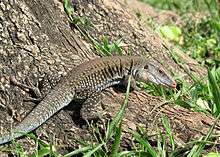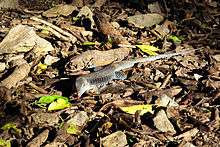Ameiva exsul
| Ameiva exsul | |
|---|---|
 | |
| Scientific classification | |
| Kingdom: | Animalia |
| Phylum: | Chordata |
| Class: | Reptilia |
| Order: | Squamata |
| Family: | Teiidae |
| Genus: | Ameiva |
| Species: | A. exsul |
| Binomial name | |
| Ameiva exsul Cope, 1862 | |
| Synonyms[2] | |
| |
Ameiva exsul (English vernacular: Puerto Rican ground lizard or common Puerto Rican ameiva; Spanish vernacular: iguana) is a species of lizard in the whiptail family.[2]

Subspecies
In addition to the nominotypical subspecies (Ameiva exsul exsul Cope, 1862) two other subspecies are recognized as being valid. Isla Mona has a smaller subspecies (Ameiva exsul alboguttata Boulenger, 1896), whereas Isla Desecheo has a larger subspecies (Ameiva exsul desechensis Heatwole & Torres, 1967).
Geographic range
Ameiva exsul is found in coastal habitats of Puerto Rico, the United States Virgin Islands, the British Virgin Islands, Isla Culebra, Isla Mona, Isla Desecheo, and most satellite islands. The species is also found in the Toro Negro State Forest.[3]
Description
Ameiva exsul is a relatively large lizard, really large males can grow up to 85 cm (33.5 inches). The maximum recorded male snout-to-vent length (SVL) is 201 mm (7.9 in), and the maximum recorded female SVL is 99 mm (3.9 in). Color patterns vary widely among individuals, populations, and islands. Animals are predominantly colored gray, black, or brown, with large or small white dots along their backs. Dorsolateral stripes vary in number, length, and color. All individuals have a white or blue-white mottled stomach. The chin shield and throat patch are often light pink. Juveniles generally have a bright blue tail and more dots than stripes.
Biology
Puerto Rican ground lizards occur in habitat with open canopy structure and loose sandy soil in elevations between sea-level and 150 m (490 ft) where the temperature is above 24 °C (75 °F) year-round.[4] Ground lizards forage for insects and small fruits and scavenge for dead animals or trash scraps in urban areas.
Reproduction
Sexually mature females of A. exsul bury 2-7 pink eggs approximately 100 mm (3.9 in) below ground in loose soil in June–August. Juveniles may have a bright blue tail, like the closely related Ameiva wetmorei (blue-tailed ground lizard), but they will lose the bright blue color in their tail with age. Individuals can live more than six years.
Threats
The principle threat to individuals of A. exsul is from other animals which eat ground lizards. Mammalian predators include feral cats, dogs, and mongooses. Avian predators include American kestrels, Greater Antillean grackles, and pearly-eyed thrashers.
See also
References
- ↑ IUCN (2016). "Ameiva exsul". IUCN Red List of Threatened Species. Version 2016.3. International Union for Conservation of Nature. Retrieved 7 December 2016.
- 1 2 "Ameiva exsul ". The Reptile Database. www.reptile-database.org.
- ↑ Bosques de Puerto Rico: Bosque Estatal de Toro Negro. Archived 2015-08-07 at the Wayback Machine. Hojas de Nuestro Ambiente. July 2008. [Publication/Issue: P-030] Puerto Rico Department of Natural and Environmental Resources. Retrieved 10 September 2013.
- ↑ Henderson RW, Powell R (2009). Natural History of West Indian Reptiles and Amphibians. Gainesville: University Press of Florida. 520 pp. ISBN 978-0813033945.
Further reading
- Boulenger GA (1896). "Ueber einige Reptilien von der Insel Mona (Westindien) ". Jahresbericht und Abhandlungen des Naturwissenschaftlichen Vereins in Magdeburg 1894-1896: 112-114. (Ameiva alboguttata, new species, pp. 112–113). (in German).
- Cope ED (1862). "Synopsis of the Species of Holcosus and Ameiva, with Diagnoses of new West Indian and South American Colubridæ". Proc. Acad. Nat. Sci. Philadelphia 14: 60-82. (Ameiva plei Var. exsul, new variation, p. 66).
- Heatwole H, Torres F (1967). "Distribution and Geographic Variation of the Ameivas of Puerto Rico and the Virgin Islands". Studies on the Fauna of Curaçao and other Caribbean Islands 24 (92): 63-111. (Ameiva desechensis, new species, pp. 95–96).
- Schwartz A, Thomas R (1975). A Check-list of West Indian Amphibians and Reptiles. Carnegie Museum of Natural History Special Publication No. 1. Pittsburgh, Pennsylvania: Carnegie Museum of Natural History. 216 pp. (Ameiva exsul, pp. 58–59).
